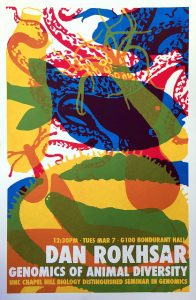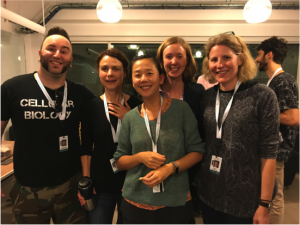Behind the scene of Embryology 2017: not just about the science
Posted by radikes, on 3 August 2017
Blog post written by Isabelle Vea – 2017 Embryology Student
All 24 of the 2017 Embryology students came to Woods Hole to learn from the best scientists in the developmental biology field. We were immersed in a unique setting to interact with established and promising investigators. In general, each invited lecturer came and spent from a few days to a couple of weeks at the Marine Biological Laboratories and was dedicated to interacting with us. Through our interactions with the faculty we quickly learned that it was more than just learning knowledge and techniques. For instance, the course directors carefully planned lunches and dinners with one faculty and two of the students allowing us to discuss informally about all sorts of topics.
In this post, I would like to share some of the interactions I had with the course faculty that are not related to embryos, yet were extremely meaningful.
Science and art
I always thought that science required creativity and so for me, art/crafts and science is a natural combination. But is it possible to combine both in our daily lives? Isn’t science already a lot? One of my most memorable discussions was with Bob Goldstein from UNC Chapel Hill, who managed to integrate his artistic views into the academic world.

Bob creates posters for scientific seminars in his department using screen printing. It was refreshing to be able to discuss screen printing techniques, inks etc. with Bob. We also discussed using arts and craft as a medium for talking about science at outreach events.
I do think it is possible to combine research with other hobbies or non-scientific activities. The bonus (and actually what Bob taught me through meeting him) is to be able to find other researchers with the same artistic interests.
If you are an artistic scientist, give a shout out in the comments! And if you are interested in discovering scientists with an artistic mind, check out #sciart on social media platforms.
Leadership
As graduate students and postdocs, our primary concern is to find the next research position. As a postdoc myself, I am still struggling to figure out what type of researcher I want to become in the long term. I have always wanted to know how one scientist decides on becoming a leader in his department or institution. Unfortunately, I have never had the opportunity to ask such questions in my home institutions. Here at the course, asking these questions seemed natural and many discussions took place informally in a pub or the hallway.
I was particularly interested to hear from Claudio Stern about his leadership experiences. Claudio Stern from UCL is involved in service to the scientific community, he is part of the scientific council at the Institut Pasteur in Paris and the previous president of the International Society of Developmental Biology. We discussed how you decide to become a leader in academia, and what opportunities may lie beyond your own lab. I learned that at some point in our science careers, we may ask ourselves whether we would like to help improve our colleagues’ work environment and to do so, we need to be able inspire them.
Enthusiasm in research
Despite my undivided love for invertebrates and the excellence of every module, my favorite week was the zebrafish/frog one. Into the second week of the course, I had been overwhelmed by C. elegans powerful tools to examine cellular mechanisms and going into vertebrate species was quite intimidating. I initially thought that my lack of knowledge in vertebrate anatomy would be detrimental to learn the techniques suggested during the module but something special happened.

The zebrafish lecturers (Elke Ober from University of Copenhagen and Tatjana Piotrowski from Stowers Institute) were very present during our lab time. They were not only physically here but kept checking on our experimental progress throughout the week and transferred a lot of their enthusiasm to us.
I had decided to perform a simple experiment that would back up my very risky one. As expected my risky experiment failed but I had managed to obtain time lapse images of the simple one. The night before show and tell, I asked one of the lecturers if there were still time to set up a new experiment: transferring cells of an embryo that I would have injected with fluorescent dye, into another embryo and see where the cells develop. I had never transferred any cells from one organism to another and the task seemed impossible to do with less than 24 hours left. But Elke just looked at me with excited eyes: “Yes! You should try! I will help you.” I could not not try.
Next thing I knew, I was injecting embryos with fluorescent dyes and transferring cells at 1 am in the very last hours of the module and both Elke and Tatjana were there as moral supports! The next day we checked the embryos, some of them survived and it worked! It was the most rewarding result of the course, not only because it worked but because I was inspired by their enthusiasm.
For sure, on a daily basis, experiments are not always successful (a big proportion of mine actually failed during the course), but just having one experiment work and a supportive and passionate community makes your day.
Overall, each faculty member came to Woods Hole with something to share with us. They taught us what they know about embryos but to me, they also conveyed their passion, shared their life experience and how this can be relatable to us, as budding independent investigators. And for this, the course was invaluable.
Isabelle Vea
Isabelle Vea is a Marie Skłodowska-Curie Fellow at the University of Edinburgh interested in the evolution of scale insects.
Twitter: @thecochenille


 (13 votes)
(13 votes)
Thanks so much for sharing this Isabelle – on the #sciart front I’d just like to point readers to three Node posts from last year, and also to say that if you want to share your art with the community, we’d love to host it on the Node!
1 – A Fusion of Art and Science by BeataScienceArt
https://thenode.biologists.com/fusion-art-science/science-art/
2 – From biology to art by Mia Buehr
https://thenode.biologists.com/mia-buehr/science-art/
3 – Life’s Symphony by Mark Hintze and Diana Gradinaru
https://thenode.biologists.com/lifes-symphony-fusion-art-science-display-beauty-development/science-art/
Funny enough, I still have this link ready to be pasted – even though it’s not recent, I was cheerful about scientist artists. I’m one of those many and better-known scientist musicians (strictly amateur as far as I’m concerned) but appreciate the visual arts as well in how they communicate.
http://lorrie.cranor.org/blog/2014/02/06/my-quilt-in-science-magazine/